EasyJet: Business Environment Analysis, Leadership, and Strategies
VerifiedAdded on 2022/12/27
|13
|4062
|67
Report
AI Summary
This report provides a comprehensive analysis of EasyJet's business operations, covering various aspects of its environment and strategies. It begins with an introduction to the business environment and then delves into SWOT and PESTEL analyses, exploring both internal and external factors influencing the airline. The SWOT analysis examines EasyJet's strengths, weaknesses, opportunities, and threats, while the PESTEL analysis assesses political, economic, social, technological, environmental, and legal factors. The report further evaluates how changes in the PESTEL factors impact the airline's opportunities and threats. It also analyzes different leadership styles, comparing them to identify the most suitable management approaches for EasyJet. The report concludes with recommendations for future growth and discusses ethical and social responsibilities within the business context.
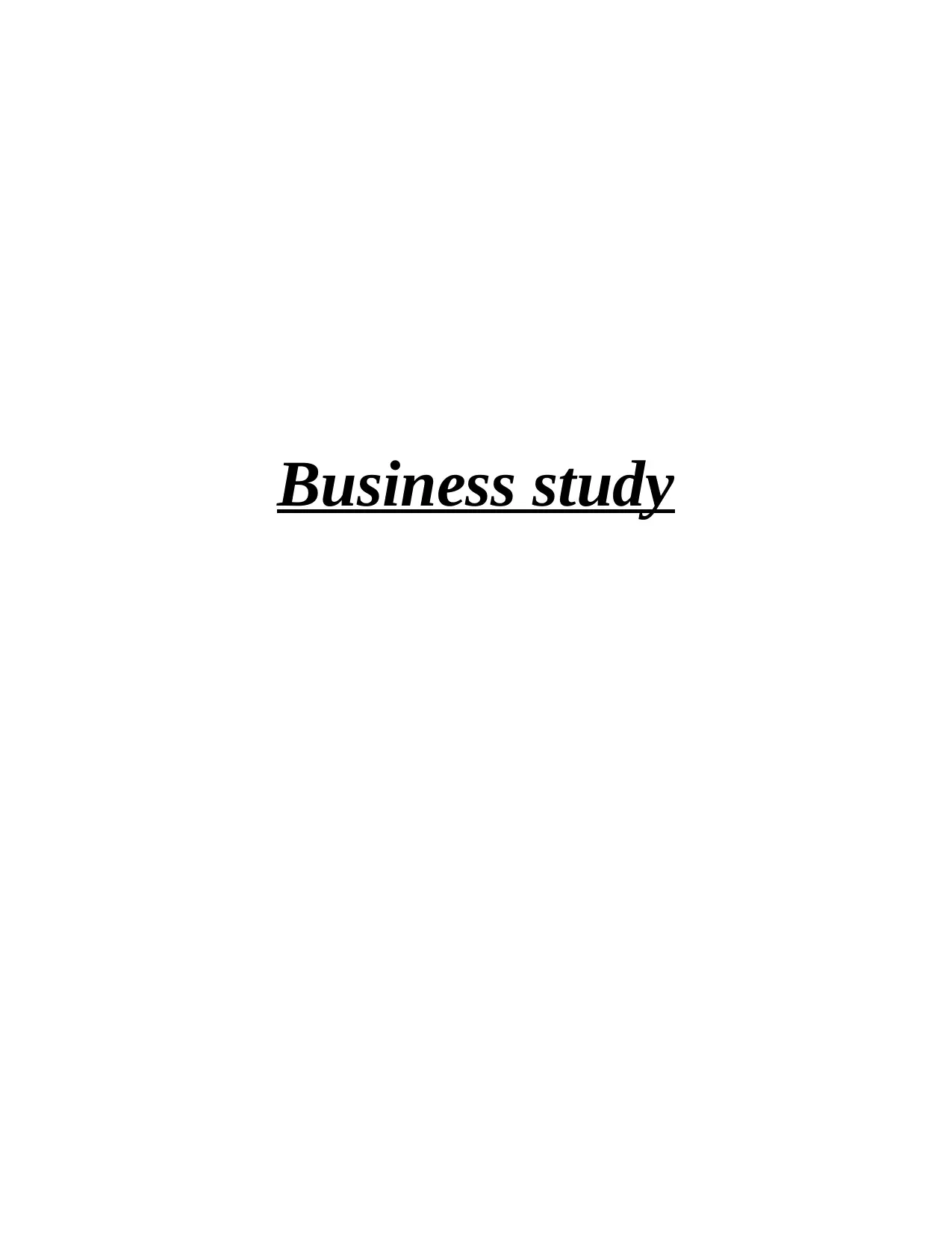
Business study
Paraphrase This Document
Need a fresh take? Get an instant paraphrase of this document with our AI Paraphraser
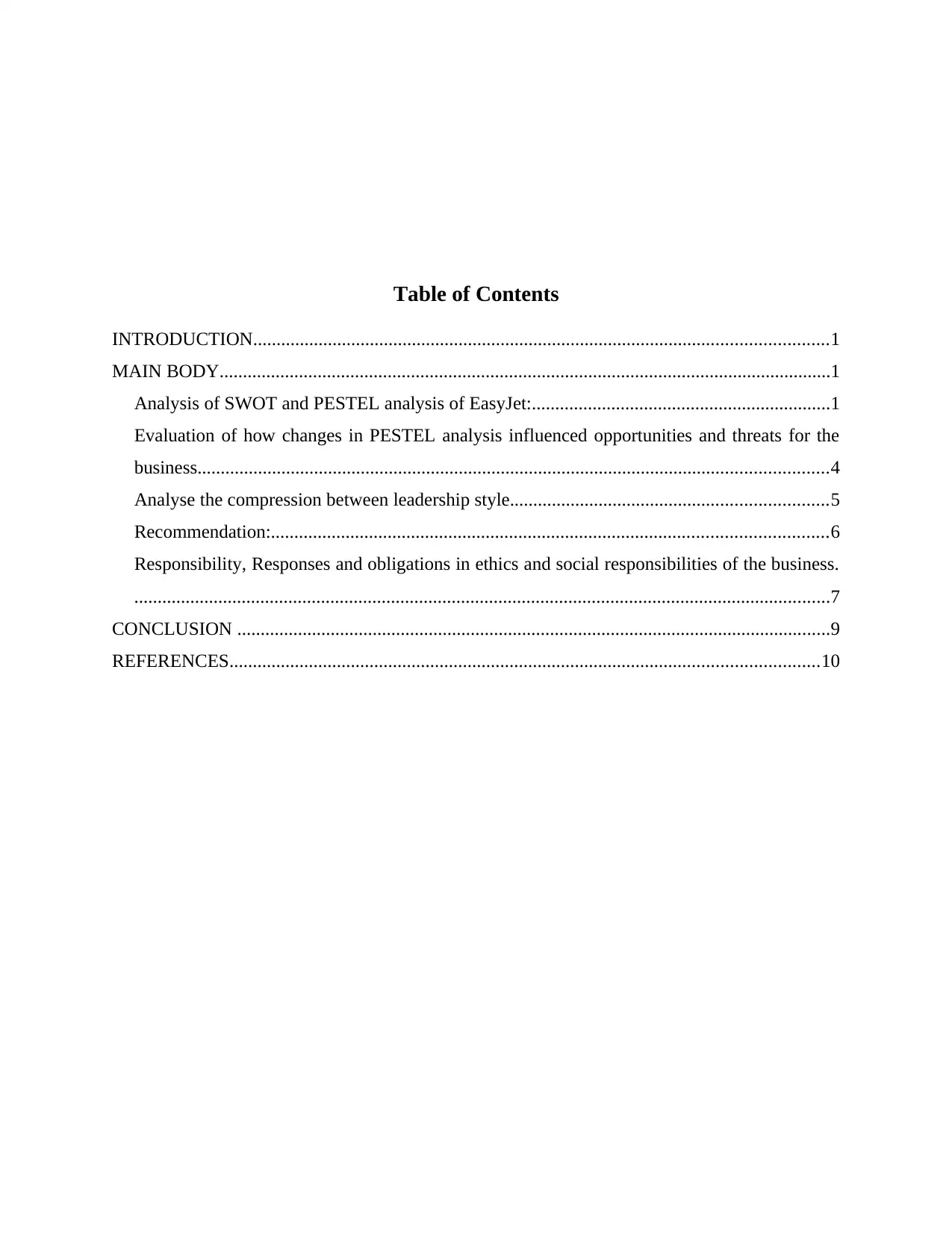
Table of Contents
INTRODUCTION...........................................................................................................................1
MAIN BODY...................................................................................................................................1
Analysis of SWOT and PESTEL analysis of EasyJet:................................................................1
Evaluation of how changes in PESTEL analysis influenced opportunities and threats for the
business.......................................................................................................................................4
Analyse the compression between leadership style....................................................................5
Recommendation:.......................................................................................................................6
Responsibility, Responses and obligations in ethics and social responsibilities of the business.
.....................................................................................................................................................7
CONCLUSION ...............................................................................................................................9
REFERENCES..............................................................................................................................10
INTRODUCTION...........................................................................................................................1
MAIN BODY...................................................................................................................................1
Analysis of SWOT and PESTEL analysis of EasyJet:................................................................1
Evaluation of how changes in PESTEL analysis influenced opportunities and threats for the
business.......................................................................................................................................4
Analyse the compression between leadership style....................................................................5
Recommendation:.......................................................................................................................6
Responsibility, Responses and obligations in ethics and social responsibilities of the business.
.....................................................................................................................................................7
CONCLUSION ...............................................................................................................................9
REFERENCES..............................................................................................................................10
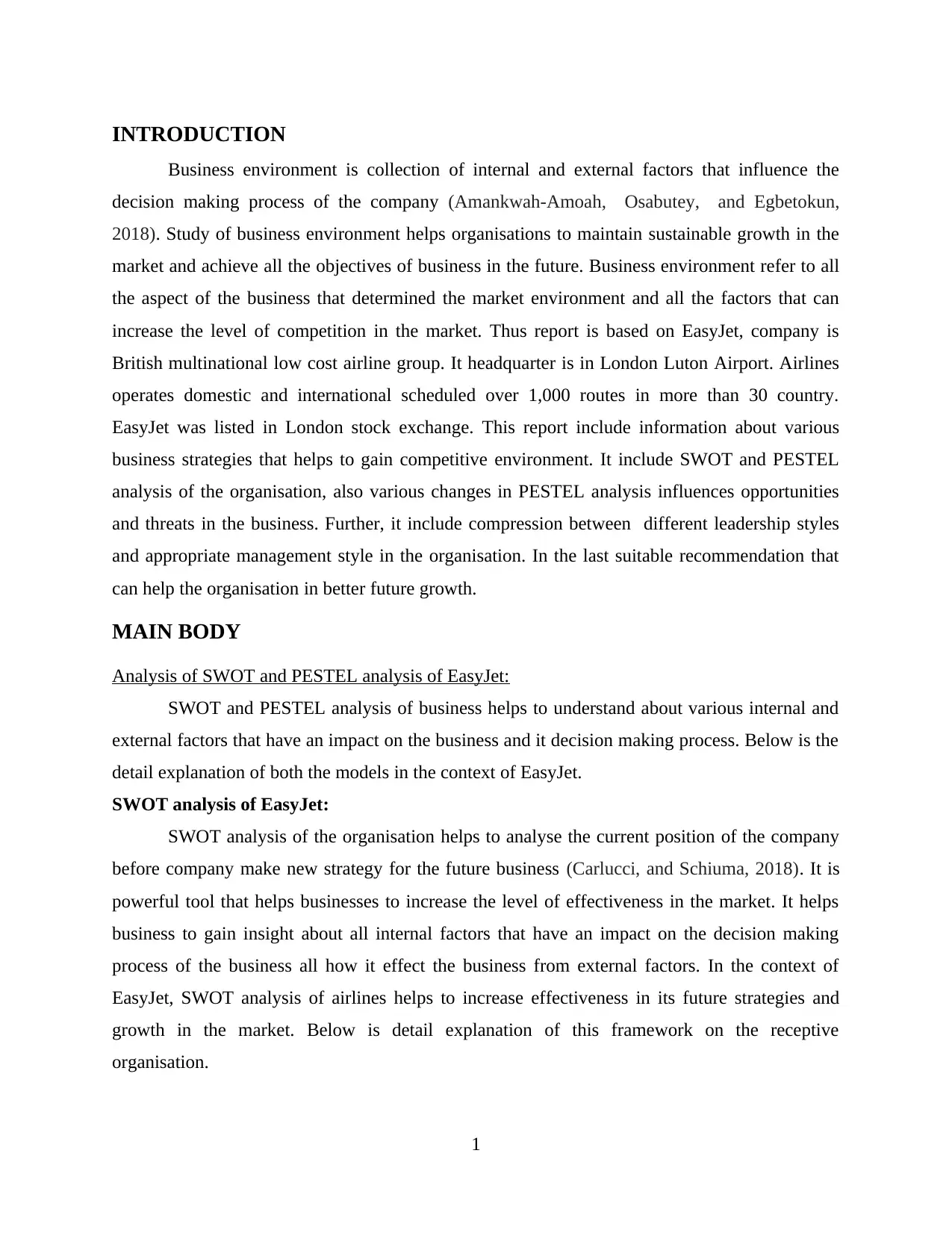
INTRODUCTION
Business environment is collection of internal and external factors that influence the
decision making process of the company (Amankwah-Amoah, Osabutey, and Egbetokun,
2018). Study of business environment helps organisations to maintain sustainable growth in the
market and achieve all the objectives of business in the future. Business environment refer to all
the aspect of the business that determined the market environment and all the factors that can
increase the level of competition in the market. Thus report is based on EasyJet, company is
British multinational low cost airline group. It headquarter is in London Luton Airport. Airlines
operates domestic and international scheduled over 1,000 routes in more than 30 country.
EasyJet was listed in London stock exchange. This report include information about various
business strategies that helps to gain competitive environment. It include SWOT and PESTEL
analysis of the organisation, also various changes in PESTEL analysis influences opportunities
and threats in the business. Further, it include compression between different leadership styles
and appropriate management style in the organisation. In the last suitable recommendation that
can help the organisation in better future growth.
MAIN BODY
Analysis of SWOT and PESTEL analysis of EasyJet:
SWOT and PESTEL analysis of business helps to understand about various internal and
external factors that have an impact on the business and it decision making process. Below is the
detail explanation of both the models in the context of EasyJet.
SWOT analysis of EasyJet:
SWOT analysis of the organisation helps to analyse the current position of the company
before company make new strategy for the future business (Carlucci, and Schiuma, 2018). It is
powerful tool that helps businesses to increase the level of effectiveness in the market. It helps
business to gain insight about all internal factors that have an impact on the decision making
process of the business all how it effect the business from external factors. In the context of
EasyJet, SWOT analysis of airlines helps to increase effectiveness in its future strategies and
growth in the market. Below is detail explanation of this framework on the receptive
organisation.
1
Business environment is collection of internal and external factors that influence the
decision making process of the company (Amankwah-Amoah, Osabutey, and Egbetokun,
2018). Study of business environment helps organisations to maintain sustainable growth in the
market and achieve all the objectives of business in the future. Business environment refer to all
the aspect of the business that determined the market environment and all the factors that can
increase the level of competition in the market. Thus report is based on EasyJet, company is
British multinational low cost airline group. It headquarter is in London Luton Airport. Airlines
operates domestic and international scheduled over 1,000 routes in more than 30 country.
EasyJet was listed in London stock exchange. This report include information about various
business strategies that helps to gain competitive environment. It include SWOT and PESTEL
analysis of the organisation, also various changes in PESTEL analysis influences opportunities
and threats in the business. Further, it include compression between different leadership styles
and appropriate management style in the organisation. In the last suitable recommendation that
can help the organisation in better future growth.
MAIN BODY
Analysis of SWOT and PESTEL analysis of EasyJet:
SWOT and PESTEL analysis of business helps to understand about various internal and
external factors that have an impact on the business and it decision making process. Below is the
detail explanation of both the models in the context of EasyJet.
SWOT analysis of EasyJet:
SWOT analysis of the organisation helps to analyse the current position of the company
before company make new strategy for the future business (Carlucci, and Schiuma, 2018). It is
powerful tool that helps businesses to increase the level of effectiveness in the market. It helps
business to gain insight about all internal factors that have an impact on the decision making
process of the business all how it effect the business from external factors. In the context of
EasyJet, SWOT analysis of airlines helps to increase effectiveness in its future strategies and
growth in the market. Below is detail explanation of this framework on the receptive
organisation.
1
⊘ This is a preview!⊘
Do you want full access?
Subscribe today to unlock all pages.

Trusted by 1+ million students worldwide
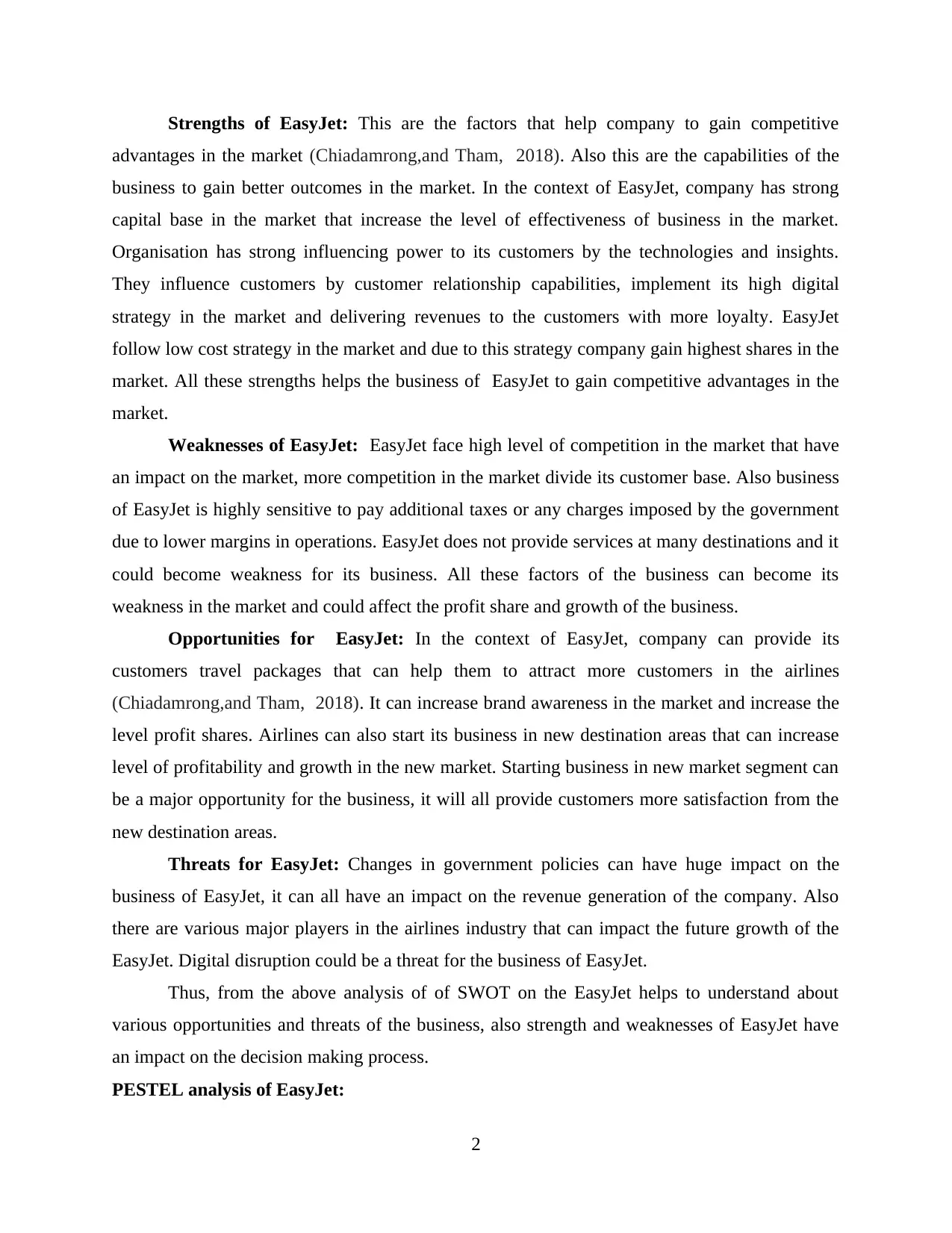
Strengths of EasyJet: This are the factors that help company to gain competitive
advantages in the market (Chiadamrong,and Tham, 2018). Also this are the capabilities of the
business to gain better outcomes in the market. In the context of EasyJet, company has strong
capital base in the market that increase the level of effectiveness of business in the market.
Organisation has strong influencing power to its customers by the technologies and insights.
They influence customers by customer relationship capabilities, implement its high digital
strategy in the market and delivering revenues to the customers with more loyalty. EasyJet
follow low cost strategy in the market and due to this strategy company gain highest shares in the
market. All these strengths helps the business of EasyJet to gain competitive advantages in the
market.
Weaknesses of EasyJet: EasyJet face high level of competition in the market that have
an impact on the market, more competition in the market divide its customer base. Also business
of EasyJet is highly sensitive to pay additional taxes or any charges imposed by the government
due to lower margins in operations. EasyJet does not provide services at many destinations and it
could become weakness for its business. All these factors of the business can become its
weakness in the market and could affect the profit share and growth of the business.
Opportunities for EasyJet: In the context of EasyJet, company can provide its
customers travel packages that can help them to attract more customers in the airlines
(Chiadamrong,and Tham, 2018). It can increase brand awareness in the market and increase the
level profit shares. Airlines can also start its business in new destination areas that can increase
level of profitability and growth in the new market. Starting business in new market segment can
be a major opportunity for the business, it will all provide customers more satisfaction from the
new destination areas.
Threats for EasyJet: Changes in government policies can have huge impact on the
business of EasyJet, it can all have an impact on the revenue generation of the company. Also
there are various major players in the airlines industry that can impact the future growth of the
EasyJet. Digital disruption could be a threat for the business of EasyJet.
Thus, from the above analysis of of SWOT on the EasyJet helps to understand about
various opportunities and threats of the business, also strength and weaknesses of EasyJet have
an impact on the decision making process.
PESTEL analysis of EasyJet:
2
advantages in the market (Chiadamrong,and Tham, 2018). Also this are the capabilities of the
business to gain better outcomes in the market. In the context of EasyJet, company has strong
capital base in the market that increase the level of effectiveness of business in the market.
Organisation has strong influencing power to its customers by the technologies and insights.
They influence customers by customer relationship capabilities, implement its high digital
strategy in the market and delivering revenues to the customers with more loyalty. EasyJet
follow low cost strategy in the market and due to this strategy company gain highest shares in the
market. All these strengths helps the business of EasyJet to gain competitive advantages in the
market.
Weaknesses of EasyJet: EasyJet face high level of competition in the market that have
an impact on the market, more competition in the market divide its customer base. Also business
of EasyJet is highly sensitive to pay additional taxes or any charges imposed by the government
due to lower margins in operations. EasyJet does not provide services at many destinations and it
could become weakness for its business. All these factors of the business can become its
weakness in the market and could affect the profit share and growth of the business.
Opportunities for EasyJet: In the context of EasyJet, company can provide its
customers travel packages that can help them to attract more customers in the airlines
(Chiadamrong,and Tham, 2018). It can increase brand awareness in the market and increase the
level profit shares. Airlines can also start its business in new destination areas that can increase
level of profitability and growth in the new market. Starting business in new market segment can
be a major opportunity for the business, it will all provide customers more satisfaction from the
new destination areas.
Threats for EasyJet: Changes in government policies can have huge impact on the
business of EasyJet, it can all have an impact on the revenue generation of the company. Also
there are various major players in the airlines industry that can impact the future growth of the
EasyJet. Digital disruption could be a threat for the business of EasyJet.
Thus, from the above analysis of of SWOT on the EasyJet helps to understand about
various opportunities and threats of the business, also strength and weaknesses of EasyJet have
an impact on the decision making process.
PESTEL analysis of EasyJet:
2
Paraphrase This Document
Need a fresh take? Get an instant paraphrase of this document with our AI Paraphraser
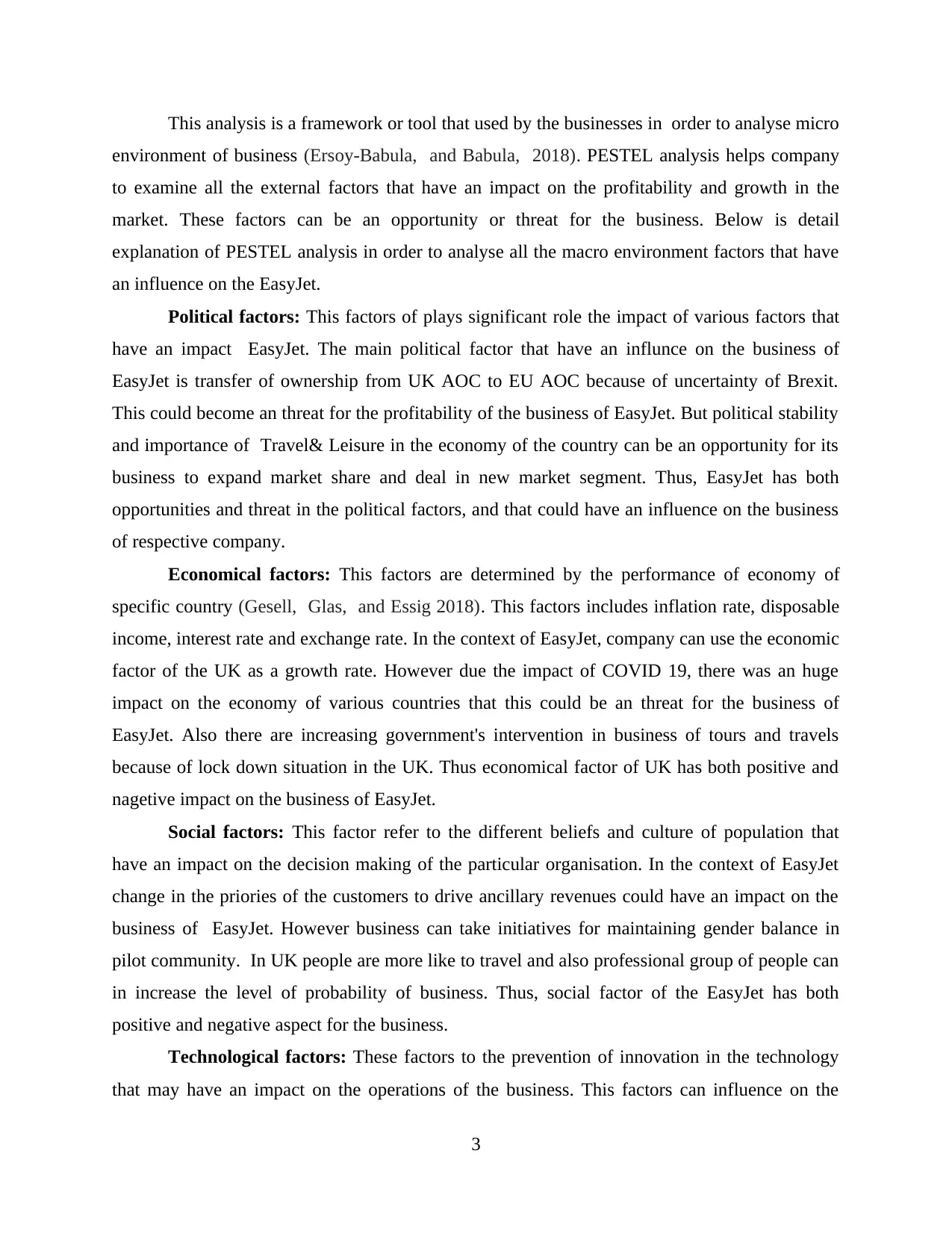
This analysis is a framework or tool that used by the businesses in order to analyse micro
environment of business (Ersoy-Babula, and Babula, 2018). PESTEL analysis helps company
to examine all the external factors that have an impact on the profitability and growth in the
market. These factors can be an opportunity or threat for the business. Below is detail
explanation of PESTEL analysis in order to analyse all the macro environment factors that have
an influence on the EasyJet.
Political factors: This factors of plays significant role the impact of various factors that
have an impact EasyJet. The main political factor that have an influnce on the business of
EasyJet is transfer of ownership from UK AOC to EU AOC because of uncertainty of Brexit.
This could become an threat for the profitability of the business of EasyJet. But political stability
and importance of Travel& Leisure in the economy of the country can be an opportunity for its
business to expand market share and deal in new market segment. Thus, EasyJet has both
opportunities and threat in the political factors, and that could have an influence on the business
of respective company.
Economical factors: This factors are determined by the performance of economy of
specific country (Gesell, Glas, and Essig 2018). This factors includes inflation rate, disposable
income, interest rate and exchange rate. In the context of EasyJet, company can use the economic
factor of the UK as a growth rate. However due the impact of COVID 19, there was an huge
impact on the economy of various countries that this could be an threat for the business of
EasyJet. Also there are increasing government's intervention in business of tours and travels
because of lock down situation in the UK. Thus economical factor of UK has both positive and
nagetive impact on the business of EasyJet.
Social factors: This factor refer to the different beliefs and culture of population that
have an impact on the decision making of the particular organisation. In the context of EasyJet
change in the priories of the customers to drive ancillary revenues could have an impact on the
business of EasyJet. However business can take initiatives for maintaining gender balance in
pilot community. In UK people are more like to travel and also professional group of people can
in increase the level of probability of business. Thus, social factor of the EasyJet has both
positive and negative aspect for the business.
Technological factors: These factors to the prevention of innovation in the technology
that may have an impact on the operations of the business. This factors can influence on the
3
environment of business (Ersoy-Babula, and Babula, 2018). PESTEL analysis helps company
to examine all the external factors that have an impact on the profitability and growth in the
market. These factors can be an opportunity or threat for the business. Below is detail
explanation of PESTEL analysis in order to analyse all the macro environment factors that have
an influence on the EasyJet.
Political factors: This factors of plays significant role the impact of various factors that
have an impact EasyJet. The main political factor that have an influnce on the business of
EasyJet is transfer of ownership from UK AOC to EU AOC because of uncertainty of Brexit.
This could become an threat for the profitability of the business of EasyJet. But political stability
and importance of Travel& Leisure in the economy of the country can be an opportunity for its
business to expand market share and deal in new market segment. Thus, EasyJet has both
opportunities and threat in the political factors, and that could have an influence on the business
of respective company.
Economical factors: This factors are determined by the performance of economy of
specific country (Gesell, Glas, and Essig 2018). This factors includes inflation rate, disposable
income, interest rate and exchange rate. In the context of EasyJet, company can use the economic
factor of the UK as a growth rate. However due the impact of COVID 19, there was an huge
impact on the economy of various countries that this could be an threat for the business of
EasyJet. Also there are increasing government's intervention in business of tours and travels
because of lock down situation in the UK. Thus economical factor of UK has both positive and
nagetive impact on the business of EasyJet.
Social factors: This factor refer to the different beliefs and culture of population that
have an impact on the decision making of the particular organisation. In the context of EasyJet
change in the priories of the customers to drive ancillary revenues could have an impact on the
business of EasyJet. However business can take initiatives for maintaining gender balance in
pilot community. In UK people are more like to travel and also professional group of people can
in increase the level of probability of business. Thus, social factor of the EasyJet has both
positive and negative aspect for the business.
Technological factors: These factors to the prevention of innovation in the technology
that may have an impact on the operations of the business. This factors can influence on the
3
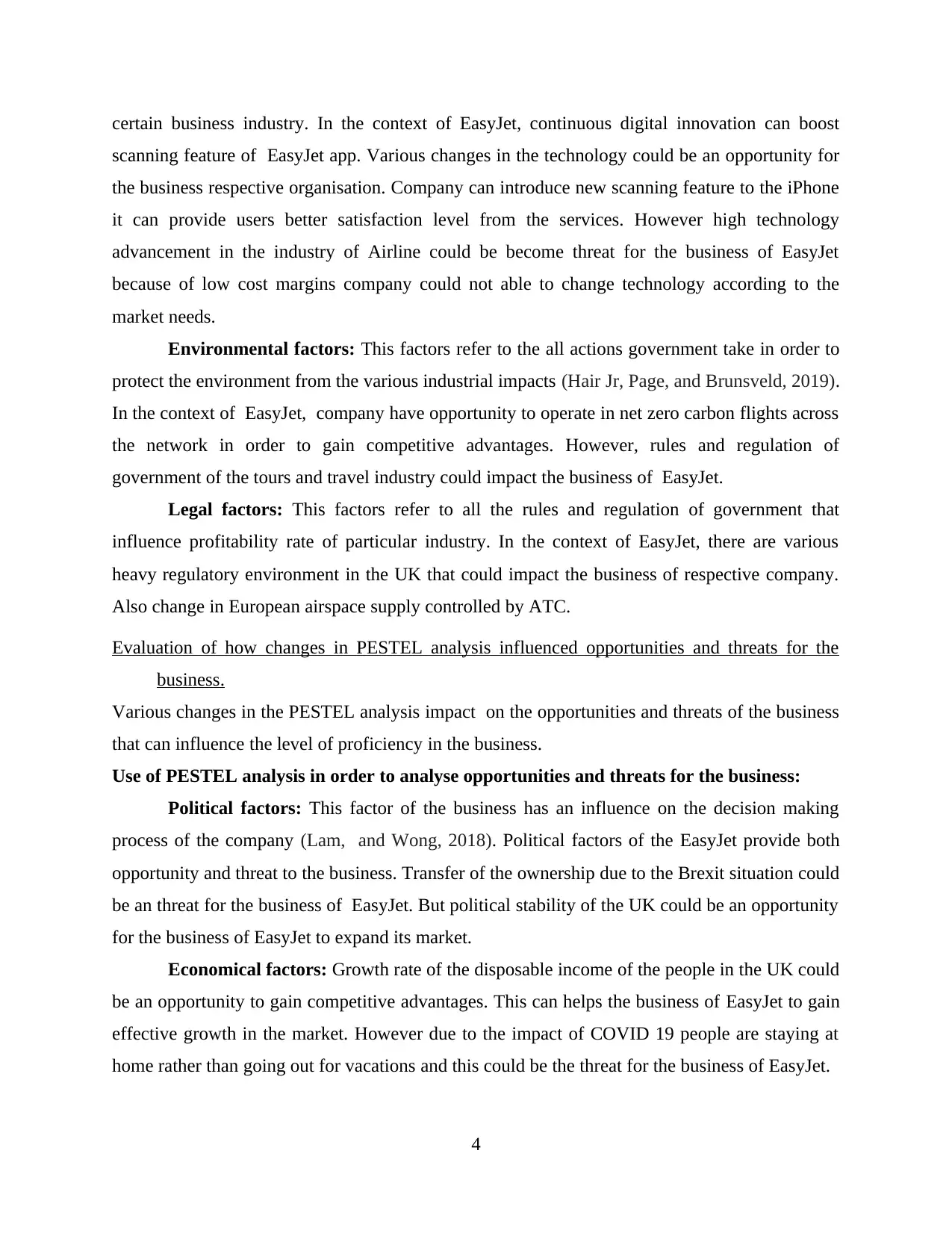
certain business industry. In the context of EasyJet, continuous digital innovation can boost
scanning feature of EasyJet app. Various changes in the technology could be an opportunity for
the business respective organisation. Company can introduce new scanning feature to the iPhone
it can provide users better satisfaction level from the services. However high technology
advancement in the industry of Airline could be become threat for the business of EasyJet
because of low cost margins company could not able to change technology according to the
market needs.
Environmental factors: This factors refer to the all actions government take in order to
protect the environment from the various industrial impacts (Hair Jr, Page, and Brunsveld, 2019).
In the context of EasyJet, company have opportunity to operate in net zero carbon flights across
the network in order to gain competitive advantages. However, rules and regulation of
government of the tours and travel industry could impact the business of EasyJet.
Legal factors: This factors refer to all the rules and regulation of government that
influence profitability rate of particular industry. In the context of EasyJet, there are various
heavy regulatory environment in the UK that could impact the business of respective company.
Also change in European airspace supply controlled by ATC.
Evaluation of how changes in PESTEL analysis influenced opportunities and threats for the
business.
Various changes in the PESTEL analysis impact on the opportunities and threats of the business
that can influence the level of proficiency in the business.
Use of PESTEL analysis in order to analyse opportunities and threats for the business:
Political factors: This factor of the business has an influence on the decision making
process of the company (Lam, and Wong, 2018). Political factors of the EasyJet provide both
opportunity and threat to the business. Transfer of the ownership due to the Brexit situation could
be an threat for the business of EasyJet. But political stability of the UK could be an opportunity
for the business of EasyJet to expand its market.
Economical factors: Growth rate of the disposable income of the people in the UK could
be an opportunity to gain competitive advantages. This can helps the business of EasyJet to gain
effective growth in the market. However due to the impact of COVID 19 people are staying at
home rather than going out for vacations and this could be the threat for the business of EasyJet.
4
scanning feature of EasyJet app. Various changes in the technology could be an opportunity for
the business respective organisation. Company can introduce new scanning feature to the iPhone
it can provide users better satisfaction level from the services. However high technology
advancement in the industry of Airline could be become threat for the business of EasyJet
because of low cost margins company could not able to change technology according to the
market needs.
Environmental factors: This factors refer to the all actions government take in order to
protect the environment from the various industrial impacts (Hair Jr, Page, and Brunsveld, 2019).
In the context of EasyJet, company have opportunity to operate in net zero carbon flights across
the network in order to gain competitive advantages. However, rules and regulation of
government of the tours and travel industry could impact the business of EasyJet.
Legal factors: This factors refer to all the rules and regulation of government that
influence profitability rate of particular industry. In the context of EasyJet, there are various
heavy regulatory environment in the UK that could impact the business of respective company.
Also change in European airspace supply controlled by ATC.
Evaluation of how changes in PESTEL analysis influenced opportunities and threats for the
business.
Various changes in the PESTEL analysis impact on the opportunities and threats of the business
that can influence the level of proficiency in the business.
Use of PESTEL analysis in order to analyse opportunities and threats for the business:
Political factors: This factor of the business has an influence on the decision making
process of the company (Lam, and Wong, 2018). Political factors of the EasyJet provide both
opportunity and threat to the business. Transfer of the ownership due to the Brexit situation could
be an threat for the business of EasyJet. But political stability of the UK could be an opportunity
for the business of EasyJet to expand its market.
Economical factors: Growth rate of the disposable income of the people in the UK could
be an opportunity to gain competitive advantages. This can helps the business of EasyJet to gain
effective growth in the market. However due to the impact of COVID 19 people are staying at
home rather than going out for vacations and this could be the threat for the business of EasyJet.
4
⊘ This is a preview!⊘
Do you want full access?
Subscribe today to unlock all pages.

Trusted by 1+ million students worldwide
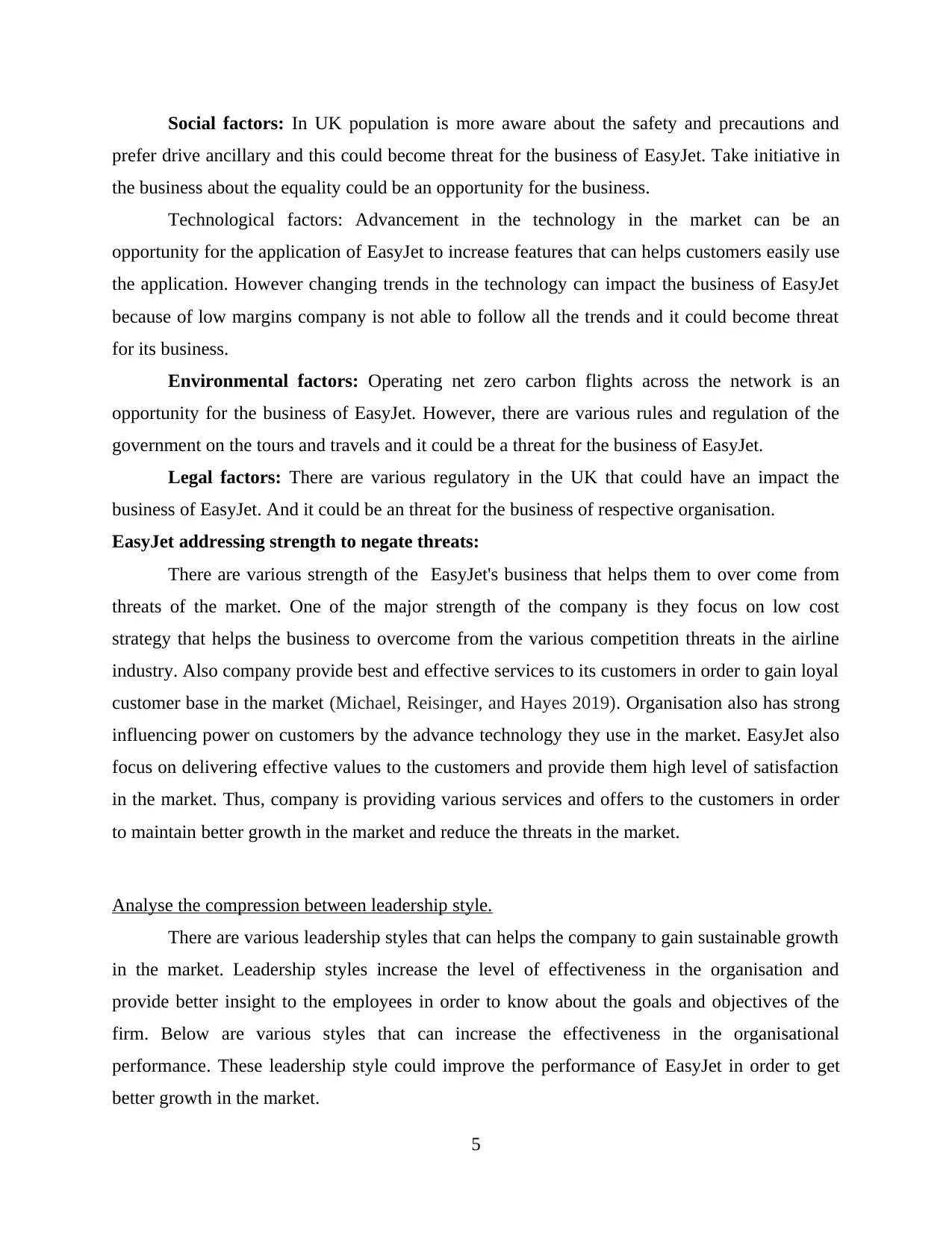
Social factors: In UK population is more aware about the safety and precautions and
prefer drive ancillary and this could become threat for the business of EasyJet. Take initiative in
the business about the equality could be an opportunity for the business.
Technological factors: Advancement in the technology in the market can be an
opportunity for the application of EasyJet to increase features that can helps customers easily use
the application. However changing trends in the technology can impact the business of EasyJet
because of low margins company is not able to follow all the trends and it could become threat
for its business.
Environmental factors: Operating net zero carbon flights across the network is an
opportunity for the business of EasyJet. However, there are various rules and regulation of the
government on the tours and travels and it could be a threat for the business of EasyJet.
Legal factors: There are various regulatory in the UK that could have an impact the
business of EasyJet. And it could be an threat for the business of respective organisation.
EasyJet addressing strength to negate threats:
There are various strength of the EasyJet's business that helps them to over come from
threats of the market. One of the major strength of the company is they focus on low cost
strategy that helps the business to overcome from the various competition threats in the airline
industry. Also company provide best and effective services to its customers in order to gain loyal
customer base in the market (Michael, Reisinger, and Hayes 2019). Organisation also has strong
influencing power on customers by the advance technology they use in the market. EasyJet also
focus on delivering effective values to the customers and provide them high level of satisfaction
in the market. Thus, company is providing various services and offers to the customers in order
to maintain better growth in the market and reduce the threats in the market.
Analyse the compression between leadership style.
There are various leadership styles that can helps the company to gain sustainable growth
in the market. Leadership styles increase the level of effectiveness in the organisation and
provide better insight to the employees in order to know about the goals and objectives of the
firm. Below are various styles that can increase the effectiveness in the organisational
performance. These leadership style could improve the performance of EasyJet in order to get
better growth in the market.
5
prefer drive ancillary and this could become threat for the business of EasyJet. Take initiative in
the business about the equality could be an opportunity for the business.
Technological factors: Advancement in the technology in the market can be an
opportunity for the application of EasyJet to increase features that can helps customers easily use
the application. However changing trends in the technology can impact the business of EasyJet
because of low margins company is not able to follow all the trends and it could become threat
for its business.
Environmental factors: Operating net zero carbon flights across the network is an
opportunity for the business of EasyJet. However, there are various rules and regulation of the
government on the tours and travels and it could be a threat for the business of EasyJet.
Legal factors: There are various regulatory in the UK that could have an impact the
business of EasyJet. And it could be an threat for the business of respective organisation.
EasyJet addressing strength to negate threats:
There are various strength of the EasyJet's business that helps them to over come from
threats of the market. One of the major strength of the company is they focus on low cost
strategy that helps the business to overcome from the various competition threats in the airline
industry. Also company provide best and effective services to its customers in order to gain loyal
customer base in the market (Michael, Reisinger, and Hayes 2019). Organisation also has strong
influencing power on customers by the advance technology they use in the market. EasyJet also
focus on delivering effective values to the customers and provide them high level of satisfaction
in the market. Thus, company is providing various services and offers to the customers in order
to maintain better growth in the market and reduce the threats in the market.
Analyse the compression between leadership style.
There are various leadership styles that can helps the company to gain sustainable growth
in the market. Leadership styles increase the level of effectiveness in the organisation and
provide better insight to the employees in order to know about the goals and objectives of the
firm. Below are various styles that can increase the effectiveness in the organisational
performance. These leadership style could improve the performance of EasyJet in order to get
better growth in the market.
5
Paraphrase This Document
Need a fresh take? Get an instant paraphrase of this document with our AI Paraphraser
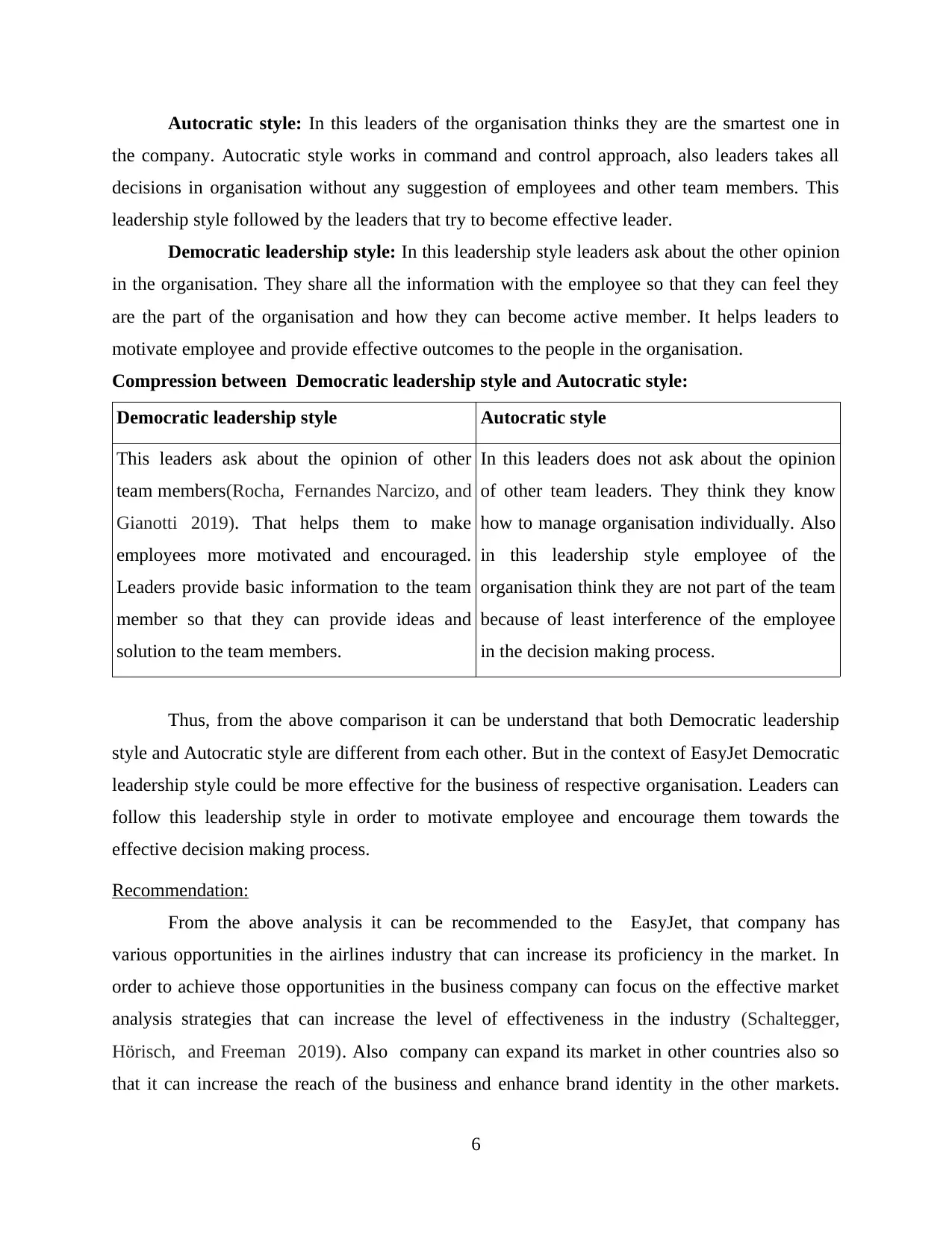
Autocratic style: In this leaders of the organisation thinks they are the smartest one in
the company. Autocratic style works in command and control approach, also leaders takes all
decisions in organisation without any suggestion of employees and other team members. This
leadership style followed by the leaders that try to become effective leader.
Democratic leadership style: In this leadership style leaders ask about the other opinion
in the organisation. They share all the information with the employee so that they can feel they
are the part of the organisation and how they can become active member. It helps leaders to
motivate employee and provide effective outcomes to the people in the organisation.
Compression between Democratic leadership style and Autocratic style:
Democratic leadership style Autocratic style
This leaders ask about the opinion of other
team members(Rocha, Fernandes Narcizo, and
Gianotti 2019). That helps them to make
employees more motivated and encouraged.
Leaders provide basic information to the team
member so that they can provide ideas and
solution to the team members.
In this leaders does not ask about the opinion
of other team leaders. They think they know
how to manage organisation individually. Also
in this leadership style employee of the
organisation think they are not part of the team
because of least interference of the employee
in the decision making process.
Thus, from the above comparison it can be understand that both Democratic leadership
style and Autocratic style are different from each other. But in the context of EasyJet Democratic
leadership style could be more effective for the business of respective organisation. Leaders can
follow this leadership style in order to motivate employee and encourage them towards the
effective decision making process.
Recommendation:
From the above analysis it can be recommended to the EasyJet, that company has
various opportunities in the airlines industry that can increase its proficiency in the market. In
order to achieve those opportunities in the business company can focus on the effective market
analysis strategies that can increase the level of effectiveness in the industry (Schaltegger,
Hörisch, and Freeman 2019). Also company can expand its market in other countries also so
that it can increase the reach of the business and enhance brand identity in the other markets.
6
the company. Autocratic style works in command and control approach, also leaders takes all
decisions in organisation without any suggestion of employees and other team members. This
leadership style followed by the leaders that try to become effective leader.
Democratic leadership style: In this leadership style leaders ask about the other opinion
in the organisation. They share all the information with the employee so that they can feel they
are the part of the organisation and how they can become active member. It helps leaders to
motivate employee and provide effective outcomes to the people in the organisation.
Compression between Democratic leadership style and Autocratic style:
Democratic leadership style Autocratic style
This leaders ask about the opinion of other
team members(Rocha, Fernandes Narcizo, and
Gianotti 2019). That helps them to make
employees more motivated and encouraged.
Leaders provide basic information to the team
member so that they can provide ideas and
solution to the team members.
In this leaders does not ask about the opinion
of other team leaders. They think they know
how to manage organisation individually. Also
in this leadership style employee of the
organisation think they are not part of the team
because of least interference of the employee
in the decision making process.
Thus, from the above comparison it can be understand that both Democratic leadership
style and Autocratic style are different from each other. But in the context of EasyJet Democratic
leadership style could be more effective for the business of respective organisation. Leaders can
follow this leadership style in order to motivate employee and encourage them towards the
effective decision making process.
Recommendation:
From the above analysis it can be recommended to the EasyJet, that company has
various opportunities in the airlines industry that can increase its proficiency in the market. In
order to achieve those opportunities in the business company can focus on the effective market
analysis strategies that can increase the level of effectiveness in the industry (Schaltegger,
Hörisch, and Freeman 2019). Also company can expand its market in other countries also so
that it can increase the reach of the business and enhance brand identity in the other markets.
6
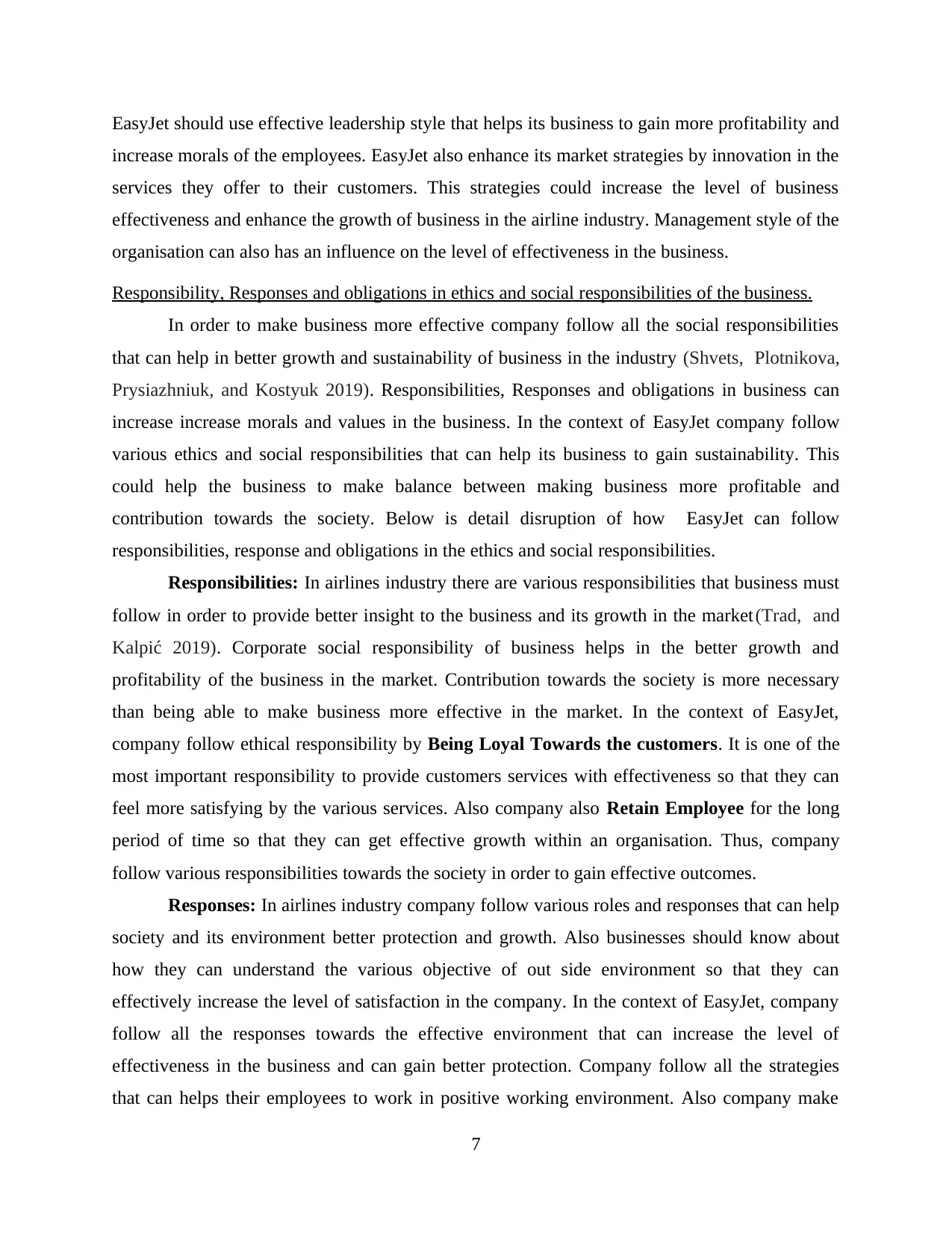
EasyJet should use effective leadership style that helps its business to gain more profitability and
increase morals of the employees. EasyJet also enhance its market strategies by innovation in the
services they offer to their customers. This strategies could increase the level of business
effectiveness and enhance the growth of business in the airline industry. Management style of the
organisation can also has an influence on the level of effectiveness in the business.
Responsibility, Responses and obligations in ethics and social responsibilities of the business.
In order to make business more effective company follow all the social responsibilities
that can help in better growth and sustainability of business in the industry (Shvets, Plotnikova,
Prysiazhniuk, and Kostyuk 2019). Responsibilities, Responses and obligations in business can
increase increase morals and values in the business. In the context of EasyJet company follow
various ethics and social responsibilities that can help its business to gain sustainability. This
could help the business to make balance between making business more profitable and
contribution towards the society. Below is detail disruption of how EasyJet can follow
responsibilities, response and obligations in the ethics and social responsibilities.
Responsibilities: In airlines industry there are various responsibilities that business must
follow in order to provide better insight to the business and its growth in the market (Trad, and
Kalpić 2019). Corporate social responsibility of business helps in the better growth and
profitability of the business in the market. Contribution towards the society is more necessary
than being able to make business more effective in the market. In the context of EasyJet,
company follow ethical responsibility by Being Loyal Towards the customers. It is one of the
most important responsibility to provide customers services with effectiveness so that they can
feel more satisfying by the various services. Also company also Retain Employee for the long
period of time so that they can get effective growth within an organisation. Thus, company
follow various responsibilities towards the society in order to gain effective outcomes.
Responses: In airlines industry company follow various roles and responses that can help
society and its environment better protection and growth. Also businesses should know about
how they can understand the various objective of out side environment so that they can
effectively increase the level of satisfaction in the company. In the context of EasyJet, company
follow all the responses towards the effective environment that can increase the level of
effectiveness in the business and can gain better protection. Company follow all the strategies
that can helps their employees to work in positive working environment. Also company make
7
increase morals of the employees. EasyJet also enhance its market strategies by innovation in the
services they offer to their customers. This strategies could increase the level of business
effectiveness and enhance the growth of business in the airline industry. Management style of the
organisation can also has an influence on the level of effectiveness in the business.
Responsibility, Responses and obligations in ethics and social responsibilities of the business.
In order to make business more effective company follow all the social responsibilities
that can help in better growth and sustainability of business in the industry (Shvets, Plotnikova,
Prysiazhniuk, and Kostyuk 2019). Responsibilities, Responses and obligations in business can
increase increase morals and values in the business. In the context of EasyJet company follow
various ethics and social responsibilities that can help its business to gain sustainability. This
could help the business to make balance between making business more profitable and
contribution towards the society. Below is detail disruption of how EasyJet can follow
responsibilities, response and obligations in the ethics and social responsibilities.
Responsibilities: In airlines industry there are various responsibilities that business must
follow in order to provide better insight to the business and its growth in the market (Trad, and
Kalpić 2019). Corporate social responsibility of business helps in the better growth and
profitability of the business in the market. Contribution towards the society is more necessary
than being able to make business more effective in the market. In the context of EasyJet,
company follow ethical responsibility by Being Loyal Towards the customers. It is one of the
most important responsibility to provide customers services with effectiveness so that they can
feel more satisfying by the various services. Also company also Retain Employee for the long
period of time so that they can get effective growth within an organisation. Thus, company
follow various responsibilities towards the society in order to gain effective outcomes.
Responses: In airlines industry company follow various roles and responses that can help
society and its environment better protection and growth. Also businesses should know about
how they can understand the various objective of out side environment so that they can
effectively increase the level of satisfaction in the company. In the context of EasyJet, company
follow all the responses towards the effective environment that can increase the level of
effectiveness in the business and can gain better protection. Company follow all the strategies
that can helps their employees to work in positive working environment. Also company make
7
⊘ This is a preview!⊘
Do you want full access?
Subscribe today to unlock all pages.

Trusted by 1+ million students worldwide
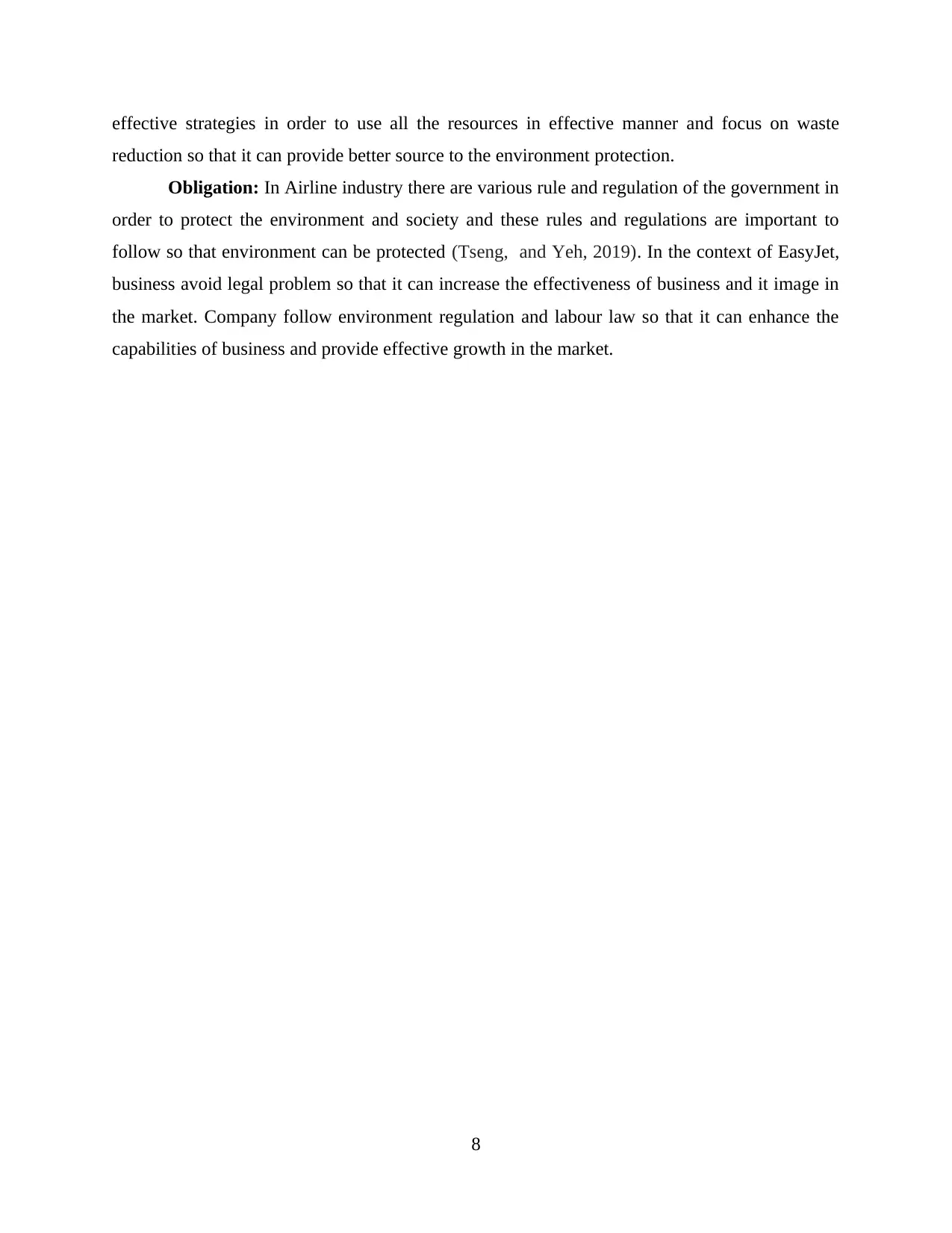
effective strategies in order to use all the resources in effective manner and focus on waste
reduction so that it can provide better source to the environment protection.
Obligation: In Airline industry there are various rule and regulation of the government in
order to protect the environment and society and these rules and regulations are important to
follow so that environment can be protected (Tseng, and Yeh, 2019). In the context of EasyJet,
business avoid legal problem so that it can increase the effectiveness of business and it image in
the market. Company follow environment regulation and labour law so that it can enhance the
capabilities of business and provide effective growth in the market.
8
reduction so that it can provide better source to the environment protection.
Obligation: In Airline industry there are various rule and regulation of the government in
order to protect the environment and society and these rules and regulations are important to
follow so that environment can be protected (Tseng, and Yeh, 2019). In the context of EasyJet,
business avoid legal problem so that it can increase the effectiveness of business and it image in
the market. Company follow environment regulation and labour law so that it can enhance the
capabilities of business and provide effective growth in the market.
8
Paraphrase This Document
Need a fresh take? Get an instant paraphrase of this document with our AI Paraphraser
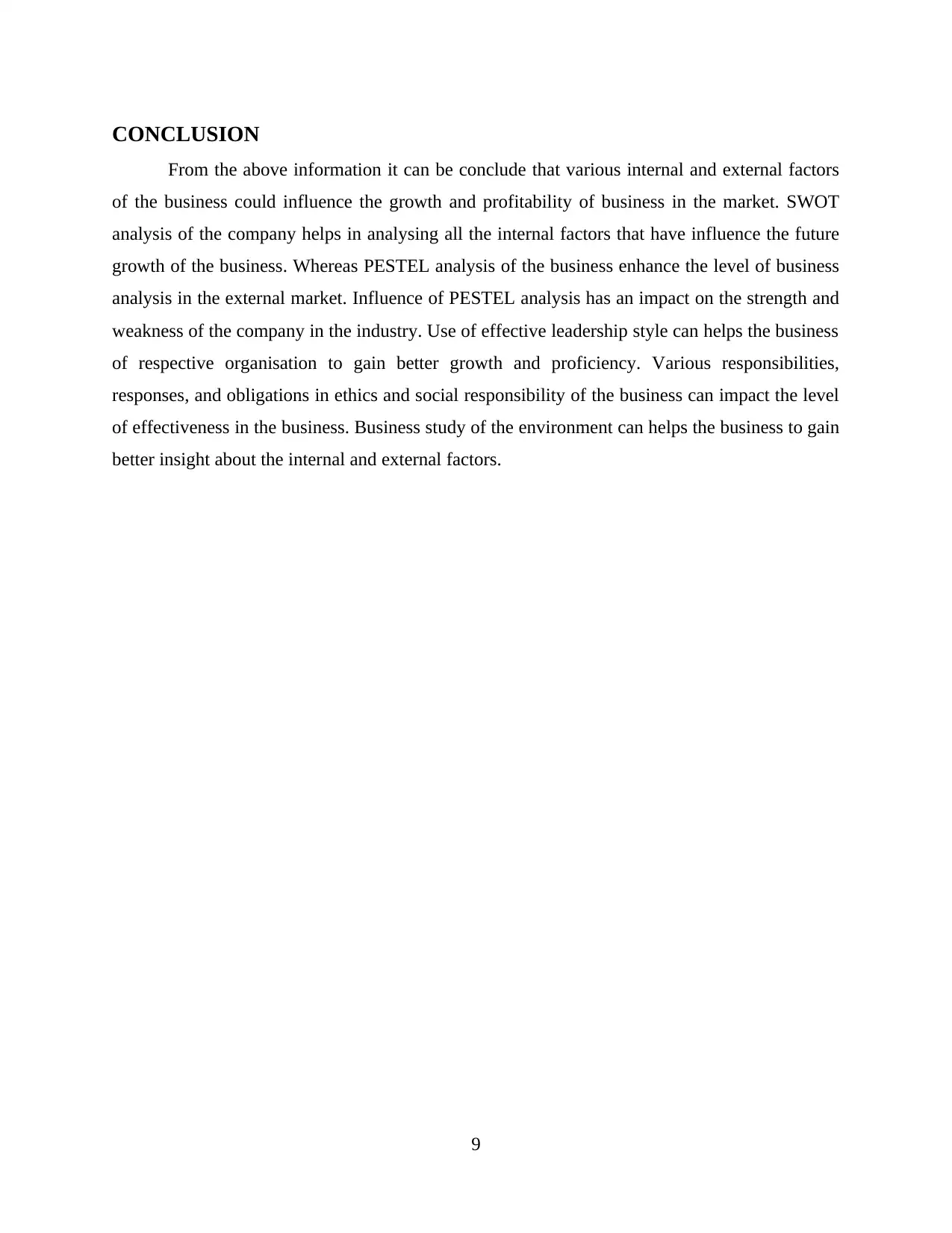
CONCLUSION
From the above information it can be conclude that various internal and external factors
of the business could influence the growth and profitability of business in the market. SWOT
analysis of the company helps in analysing all the internal factors that have influence the future
growth of the business. Whereas PESTEL analysis of the business enhance the level of business
analysis in the external market. Influence of PESTEL analysis has an impact on the strength and
weakness of the company in the industry. Use of effective leadership style can helps the business
of respective organisation to gain better growth and proficiency. Various responsibilities,
responses, and obligations in ethics and social responsibility of the business can impact the level
of effectiveness in the business. Business study of the environment can helps the business to gain
better insight about the internal and external factors.
9
From the above information it can be conclude that various internal and external factors
of the business could influence the growth and profitability of business in the market. SWOT
analysis of the company helps in analysing all the internal factors that have influence the future
growth of the business. Whereas PESTEL analysis of the business enhance the level of business
analysis in the external market. Influence of PESTEL analysis has an impact on the strength and
weakness of the company in the industry. Use of effective leadership style can helps the business
of respective organisation to gain better growth and proficiency. Various responsibilities,
responses, and obligations in ethics and social responsibility of the business can impact the level
of effectiveness in the business. Business study of the environment can helps the business to gain
better insight about the internal and external factors.
9
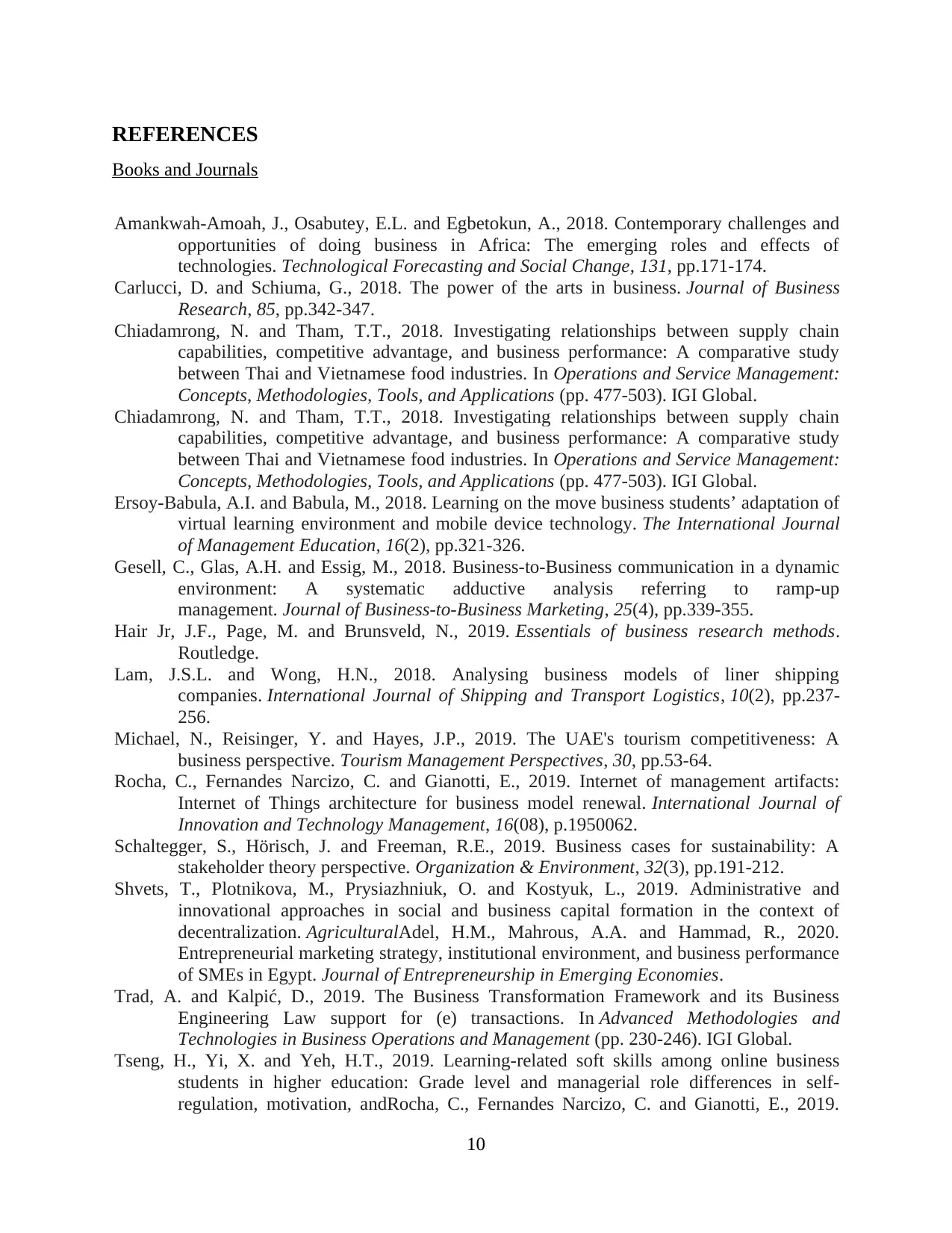
REFERENCES
Books and Journals
Amankwah-Amoah, J., Osabutey, E.L. and Egbetokun, A., 2018. Contemporary challenges and
opportunities of doing business in Africa: The emerging roles and effects of
technologies. Technological Forecasting and Social Change, 131, pp.171-174.
Carlucci, D. and Schiuma, G., 2018. The power of the arts in business. Journal of Business
Research, 85, pp.342-347.
Chiadamrong, N. and Tham, T.T., 2018. Investigating relationships between supply chain
capabilities, competitive advantage, and business performance: A comparative study
between Thai and Vietnamese food industries. In Operations and Service Management:
Concepts, Methodologies, Tools, and Applications (pp. 477-503). IGI Global.
Chiadamrong, N. and Tham, T.T., 2018. Investigating relationships between supply chain
capabilities, competitive advantage, and business performance: A comparative study
between Thai and Vietnamese food industries. In Operations and Service Management:
Concepts, Methodologies, Tools, and Applications (pp. 477-503). IGI Global.
Ersoy-Babula, A.I. and Babula, M., 2018. Learning on the move business students’ adaptation of
virtual learning environment and mobile device technology. The International Journal
of Management Education, 16(2), pp.321-326.
Gesell, C., Glas, A.H. and Essig, M., 2018. Business-to-Business communication in a dynamic
environment: A systematic adductive analysis referring to ramp-up
management. Journal of Business-to-Business Marketing, 25(4), pp.339-355.
Hair Jr, J.F., Page, M. and Brunsveld, N., 2019. Essentials of business research methods.
Routledge.
Lam, J.S.L. and Wong, H.N., 2018. Analysing business models of liner shipping
companies. International Journal of Shipping and Transport Logistics, 10(2), pp.237-
256.
Michael, N., Reisinger, Y. and Hayes, J.P., 2019. The UAE's tourism competitiveness: A
business perspective. Tourism Management Perspectives, 30, pp.53-64.
Rocha, C., Fernandes Narcizo, C. and Gianotti, E., 2019. Internet of management artifacts:
Internet of Things architecture for business model renewal. International Journal of
Innovation and Technology Management, 16(08), p.1950062.
Schaltegger, S., Hörisch, J. and Freeman, R.E., 2019. Business cases for sustainability: A
stakeholder theory perspective. Organization & Environment, 32(3), pp.191-212.
Shvets, T., Plotnikova, M., Prysiazhniuk, O. and Kostyuk, L., 2019. Administrative and
innovational approaches in social and business capital formation in the context of
decentralization. AgriculturalAdel, H.M., Mahrous, A.A. and Hammad, R., 2020.
Entrepreneurial marketing strategy, institutional environment, and business performance
of SMEs in Egypt. Journal of Entrepreneurship in Emerging Economies.
Trad, A. and Kalpić, D., 2019. The Business Transformation Framework and its Business
Engineering Law support for (e) transactions. In Advanced Methodologies and
Technologies in Business Operations and Management (pp. 230-246). IGI Global.
Tseng, H., Yi, X. and Yeh, H.T., 2019. Learning-related soft skills among online business
students in higher education: Grade level and managerial role differences in self-
regulation, motivation, andRocha, C., Fernandes Narcizo, C. and Gianotti, E., 2019.
10
Books and Journals
Amankwah-Amoah, J., Osabutey, E.L. and Egbetokun, A., 2018. Contemporary challenges and
opportunities of doing business in Africa: The emerging roles and effects of
technologies. Technological Forecasting and Social Change, 131, pp.171-174.
Carlucci, D. and Schiuma, G., 2018. The power of the arts in business. Journal of Business
Research, 85, pp.342-347.
Chiadamrong, N. and Tham, T.T., 2018. Investigating relationships between supply chain
capabilities, competitive advantage, and business performance: A comparative study
between Thai and Vietnamese food industries. In Operations and Service Management:
Concepts, Methodologies, Tools, and Applications (pp. 477-503). IGI Global.
Chiadamrong, N. and Tham, T.T., 2018. Investigating relationships between supply chain
capabilities, competitive advantage, and business performance: A comparative study
between Thai and Vietnamese food industries. In Operations and Service Management:
Concepts, Methodologies, Tools, and Applications (pp. 477-503). IGI Global.
Ersoy-Babula, A.I. and Babula, M., 2018. Learning on the move business students’ adaptation of
virtual learning environment and mobile device technology. The International Journal
of Management Education, 16(2), pp.321-326.
Gesell, C., Glas, A.H. and Essig, M., 2018. Business-to-Business communication in a dynamic
environment: A systematic adductive analysis referring to ramp-up
management. Journal of Business-to-Business Marketing, 25(4), pp.339-355.
Hair Jr, J.F., Page, M. and Brunsveld, N., 2019. Essentials of business research methods.
Routledge.
Lam, J.S.L. and Wong, H.N., 2018. Analysing business models of liner shipping
companies. International Journal of Shipping and Transport Logistics, 10(2), pp.237-
256.
Michael, N., Reisinger, Y. and Hayes, J.P., 2019. The UAE's tourism competitiveness: A
business perspective. Tourism Management Perspectives, 30, pp.53-64.
Rocha, C., Fernandes Narcizo, C. and Gianotti, E., 2019. Internet of management artifacts:
Internet of Things architecture for business model renewal. International Journal of
Innovation and Technology Management, 16(08), p.1950062.
Schaltegger, S., Hörisch, J. and Freeman, R.E., 2019. Business cases for sustainability: A
stakeholder theory perspective. Organization & Environment, 32(3), pp.191-212.
Shvets, T., Plotnikova, M., Prysiazhniuk, O. and Kostyuk, L., 2019. Administrative and
innovational approaches in social and business capital formation in the context of
decentralization. AgriculturalAdel, H.M., Mahrous, A.A. and Hammad, R., 2020.
Entrepreneurial marketing strategy, institutional environment, and business performance
of SMEs in Egypt. Journal of Entrepreneurship in Emerging Economies.
Trad, A. and Kalpić, D., 2019. The Business Transformation Framework and its Business
Engineering Law support for (e) transactions. In Advanced Methodologies and
Technologies in Business Operations and Management (pp. 230-246). IGI Global.
Tseng, H., Yi, X. and Yeh, H.T., 2019. Learning-related soft skills among online business
students in higher education: Grade level and managerial role differences in self-
regulation, motivation, andRocha, C., Fernandes Narcizo, C. and Gianotti, E., 2019.
10
⊘ This is a preview!⊘
Do you want full access?
Subscribe today to unlock all pages.

Trusted by 1+ million students worldwide
1 out of 13
Related Documents
Your All-in-One AI-Powered Toolkit for Academic Success.
+13062052269
info@desklib.com
Available 24*7 on WhatsApp / Email
![[object Object]](/_next/static/media/star-bottom.7253800d.svg)
Unlock your academic potential
Copyright © 2020–2025 A2Z Services. All Rights Reserved. Developed and managed by ZUCOL.




